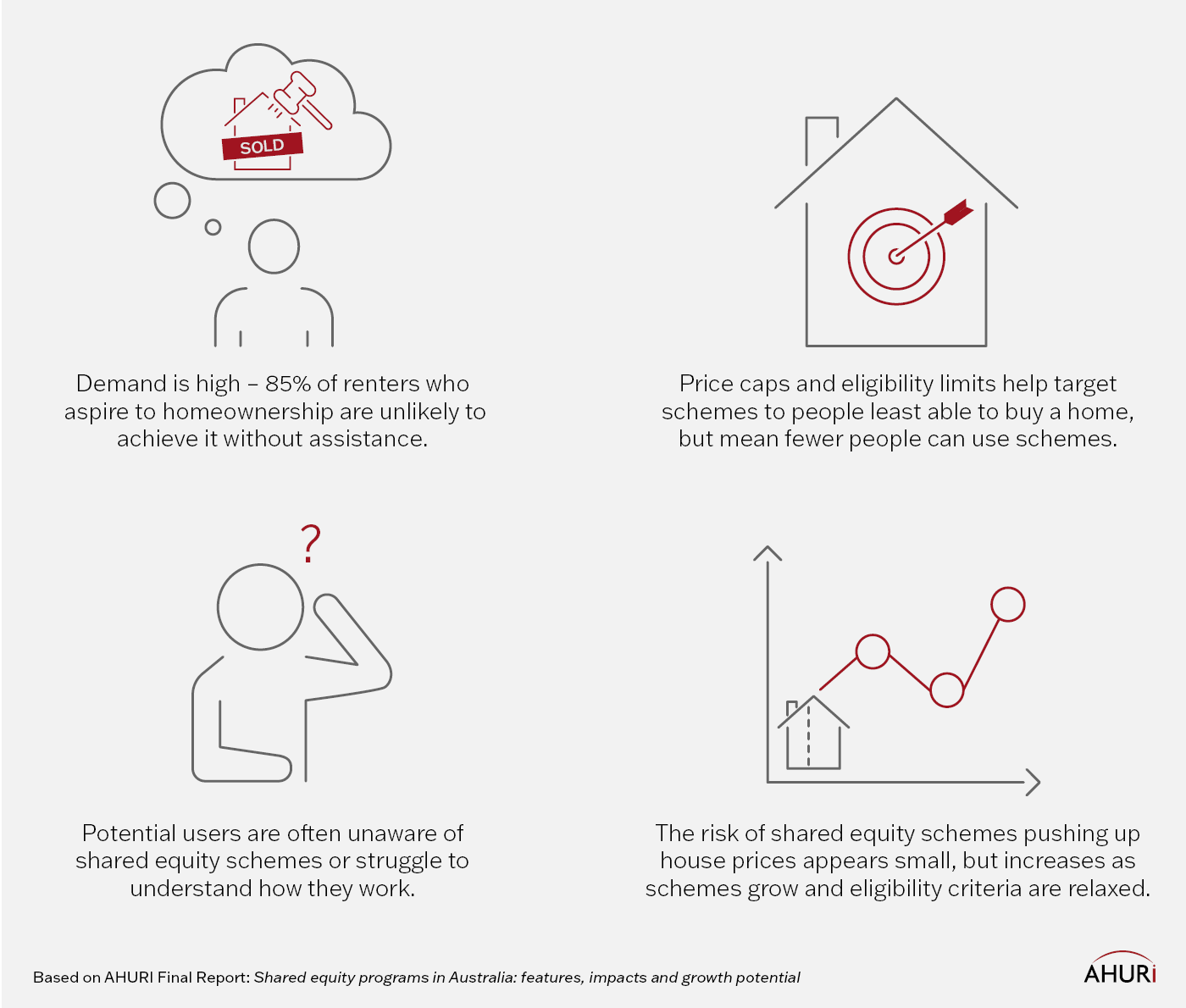What this research is about
This research looks at shared equity schemes, which are programs where governments or other organisations help people buy a home in exchange for part-ownership of the property. It compares the advantages, disadvantages and unintended consequences of different models, and creates an evidence-base to support the design of future government-led shared equity programs.
Why this research is important
With more people struggling to buy their first home, Federal, State and Territory Governments are increasingly adopting shared equity schemes to help Australians purchase a property. Ensuring these schemes are well designed and easily understandable can help ensure they are fit-for-purpose, maximise desired outcomes, and avoid unintended consequences like house price inflation.
-
At a glance
-
Key findings
A trade-off between targeting schemes and making them more accessible
Most shared equity schemes impose eligibility criteria on applicants. These may include:
- below-average income
- property price limits at or below average prices for the region
- targeting access by priority groups.
Schemes with more stringent criteria are available to fewer people, but better target customers who would otherwise be unable to buy a home. Schemes with less stringent criteria are open to more people but are less targeted.
Eligibility settings have a significant impact on schemes’ ability to target support. As little as two per cent of users of stricter schemes were able to buy without support. In schemes with looser criteria, this figure rose to 35 per cent of users.
Schemes are less effective in more expensive cities
Many schemes underestimate affordability challenges for homebuyers in major capital cities. This suggests the schemes are less effective at supporting aspiring homebuyers in larger cities.
Barriers to shared equity models
There are several obstacles that can inhibit shared equity schemes growing and taking on more customers:
- Shared equity purchases are more complex than traditional home purchases, and there are not enough support services to match. This results in limited use of the schemes.
- Shared equity schemes may contribute to house price rises, as they help people buy who otherwise would not have been able to, adding to demand.
- There are concerns over whether shared equity schemes are financially sustainable as they currently depend on government funding.
-
Policy actions
Simplifying scheme design and process
Providers could simplify schemes and the process of writing loans. There is also a need for clearer messaging on maintenance and renovations rules, what happens after a home is purchased, and how price growth is shared between the scheme provider and the homebuyer. A one-stop advice centre could be set up to ensure consumers can get the information they need easily.
Enhancing consumer understanding
It is important participants are educated about the nature of shared equity loans. Interest rates for shared equity home loans are typically higher than mainstream home loans and users should understand why, and what impact this can have.
Creating advice services and tools to assist with long-term planning
Bespoke support services and up-to-date tools would help consumers plan how they can use shared equity to secure long-term housing. These should map out the full spectrum of initiatives available and provide information on how well different initiatives might suit a user’s circumstances.
Setting market-sensitive property price thresholds
Any property price caps used in shared equity schemes should be set with specific locations’ property market conditions in mind. This will help ensure homebuyers in less affordable cities are not disadvantaged.
Exploring new methods of funding
Funding can be a barrier to scaling up government-backed shared equity programs. There is an opportunity for governments to draw lessons from private providers on how to unlock investor interest in shared equity. For example, innovative ‘patient equity’ investment or bond arrangements could allow government-led shared equity schemes to attract private investor capital and grow without affecting their core purpose.
Filling data gaps for customers
There is a need to gather accurate and up-to-date information about the long-term impacts of shared equity programs and make it publicly available. This will help prospective users decide if shared equity programs are right for them.
Filling data gaps for providers
Historical loan-book data from government and private shared equity schemes could be collected to show how existing products are working. This data would allow governments to assess the level of risk schemes carry, how sustainable they are, and what level of return they provide. The data could also build confidence in the investment and help attract more funding.
Independent monitoring
There is a need for regular, mandated and independent evaluations of shared equity programs to build an evidence base to help schemes develop and improve. This monitoring would also help governments compare shared equity to other assistance programs, such as home loan guarantee schemes, to determine which represent the best value for money, and which should be scaled up.
-
Research design
This research included a review of 19 shared equity schemes in Australia, Canada, Ireland and the UK since the 1990s. Each was assessed for design, effectiveness, and unintended consequences. Predictive modelling was performed on six of the schemes to predict their longer-term impact on housing distribution. A review of customer experiences of Australian shared equity schemes was also undertaken, which included an online review and in-depth interviews with six current or prospective users. Finally, interviews were conducted with government and private providers of shared equity programs and other stakeholders to assess challenges in the sector, and the prospects for such schemes.



